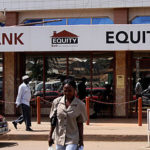There was a reduction of 5.2 percent in the banking industry’s stock of non-performing loans (NPLs) to Shs514.9 billion as at end of June 2019, from 542.8 billion registered in the same period of the previous year, according to the latest financial stability report released on Tuesday by the industry regulator, the Bank of Uganda (BOU).
The report says that as the ratio of non-performing loans to gross loans reduced over the year ended June 2019, the asset quality improved to 3.8 percent in June 2019 from 4.4 percent in June 2018. While the gross loans, the denominator in the NPL ratio indicator, increased by 11.2 percent.
The “big five” sectors – agriculture; manufacturing; trade; building, construction and real estate; and personal and household – accounted for 85.1 percent of total NPLs (and 84.4 percent of the banking industry gross loans) as at end June 2019, up from 83.9 percent of NPLs (and 83.6 percent of gross loans) as at end June 2018.
However, according to BOU, the asset quality under the agriculture sector remains a concern, in spite of the sector accounting for just 12.6 percent of the banking industry gross loans. Notwithstanding the improvement in the sector’s NPL ratio from 11.0 percent to 9.1 percent over the year, the sector still accounted for the highest proportion of the banking industry NPLs, at 30.4 percent, similar to June 2018 contribution (30.3 percent).
Also, the manufacturing sector’s deteriorating asset quality trend persisted, having started in December 2017. The sector registered a 20.5 percent increase in NPLs over the year ended June 2019, deterioration from the 9.8 percent growth over the prior year ended June 2018. Indeed, its contribution to the banking industry total NPLs rose from 4.1 percent to 10.1 percent over the year.
As a positive for financial stability, asset quality under the main beneficiary sectors of credit – building, construction and real estate; and trade and commerce – improved, with their NPL ratio reducing from 3.4 percent and 5.2 percent to 3.0 percent and 3.2 percent respectively. Furthermore, there was improvement in asset quality attributed to personal and household lending, indicating lower distress and improving capacity for households to service credit obligations.
Consistent with the reduction in the proportion of foreign currency denominated loans, the share of foreign currency denominated NPLs in total NPLs reduced from 39.8 percent to 27.0 percent over the year, with foreign currency NPLs estimated at Shs139.0 billion as at end June 2019. Consequently, the aggregate foreign currency NPL ratio decreased from 4.6 percent to 2.8 percent over the year, with the improvement reflected across most of the sectors.
Notable though was the high share of NPLs of 51.1 percent attributed to the agriculture sector, in spite of its 15.1 percent share in gross foreign currency loans, representing the highest sectoral foreign currency NPL ratio of 9.5 percent.
The stable and accommodative interest rates regime, improvement in the performance of the economy and government’s settlement of domestic arrears supported improvement in asset quality. Through FY2018/19, the monthly lending rates on shilling and foreign currency loans averaged 20.0 percent and 7.5 percent, down from 20.3 percent and 7.7 percent in FY2017/18, respectively.
Earnings and Profitability
The aggregate profitability of the banking industry improved. However, the persistently loss-making trend of the smaller banks remains a concern, says the report. The banking sector’s aggregate net-after-tax profit increased by 5.3 percent to Shs776.7 billion in FY 2018/19 from Shs737.7 billion (FY2017/18), largely driven by interest income on advances and treasury securities that increased by 9.3 percent and 8.3 percent respectively.
The improvement in asset quality also contributed to improved profitability through a lower increase in provisions of 5.6 percent in spite of the 11.2 percent growth in lending. However, the aggregate net interest margin (NIM) declined, as highlighted in the figure above, due to a lower growth in net interest income, by 9.6 percent, in spite of the earning assets registering a greater increase, of 16.1 percent.
The lower growth in net interest income was attributed to the mostly muted interest rate regime, relative to the prior year. The year ended June 2019 saw a marginal reduction in interest rates on shillings loans, which constitute most of the earning assets, while interest rates on treasury securities only increased marginally.
Also, the industry’s return on assets (ROA) and return on Equity (ROE) reduced from 2.8 percent and 16.7 percent in June 2018 to 2.7 percent and 15.9 percent respectively, in June 2019. This was attributed to a higher increase in total assets, of 10.5 percent, and shareholders’ equity, of 10.8 percent, compared to the 5.3 percent increase in net-after-tax profits.
The aggregate industry retail deposits increased by 8.8 percent over the year ended June 2019, to Shs21 trillion. However, as noted by BOU, the growth was slower compared to a 12.5 percent increase registered over the prior year ended June 2018. Shilling deposits grew at a faster rate of 13.0 percent, than foreign currency deposits, at 8.0 percent, over the year under review.
Foreign currency deposits to total deposits reduced
Consequently, the proportion of foreign currency deposits to total deposits reduced from 38.4 percent to 38.2 percent. With the proportion of foreign currency denominated loans in total loans similarly falling and reducing banks’ exposure to foreign exchange rate risk.
Furthermore, the ratio of foreign currency loans to foreign currency deposits reduced from 62.9 percent (June 2018) to 61.8 percent (June 2019). This indicates increased funding for foreign currency loans, and points to a reduction in the associated liquidity risk in the event of increased credit and foreign exchange risk.
The cost of deposits to banks reduced
The cost of deposits to banks reduced from 2.5 percent FY2017/18 to 2.3 percent for FY2018/19.
Banks’ access to wholesale funding improved, amidst stable interest rates in the money markets, with the main sources being the domestic interbank market and the foreign currency swaps market. While the overnight and 7-day interbank rates averaged 8.6 percent and 10.2 percent in FY2018/19, up from 7.9 percent and 9.7 percent in FY2017/18, respectively, the interbank transacted amount increased from Shs25.0 trillion to Shs26.3 trillion.
Turnover in the swaps market also increased, to Shs37.9 trillion in FY2018/19 from Shs31.1 trillion in FY2017/18, with banks transacting with both resident and non-resident financial institutions.
Liquidity
Liquidity risk in the banking system remained low, as banks maintained liquidity buffers well above the prudential minimum requirements. However, stress tests indicated that banks’ resilience to liquidity shocks somewhat waned as their excess liquidity buffers reduced.
While deposits increased by 8.8 percent, liquid assets increased at a slower pace of 6.3 percent due to a shift towards both longer-term and less liquid assets. “Notably, the stronger growth in banks’ lending to the private sector, of 11.2 percent, claimed an increasing proportion of deposits, of 64.7 percent as at end of June 2019.”
Furthermore, the faster growth, of 14.7 percent, in banks’ investment in government securities was skewed to more long-term government securities, which are less liquid. Consequently, the liquid assets-to-total deposits ratio declined from 46.6 percent in June 2018 to 45.5 percent in June 2019. However, this is more than double the regulatory minimum requirement of 20 percent. Similarly, the liquid assets ratio dropped to 31.6 percent.
Liquidity coverage ratio for the aggregate industry balance sheet reduced
The Liquidity coverage ratio (LCR) for the aggregate industry balance sheet reduced from 372.4 percent to 211.4 percent over the year, but remained well above the prudential minimum, of 100 percent. All banks, but one, held sufficient high quality liquid assets (HQLA) to sustain them through a 30-day stress scenario, for all currencies. “Stress tests conducted on the banking system’s resilience to liquidity shocks, indicated reduced banks’ capacity to withstand shocks, over the year ended June 2019.”
Capital adequacy
BOU reports that capital buffers and adequacy improved, reinforcing the banking system’s resilience to shocks. During FY2018/19, all commercial banks maintained capital adequacy ratios (CAR) well above the minimum requirement of 10 percent for core capital to total risk weighted assets and 12 percent for total capital to total risk weighted assets.
The aggregate industry core capital and total capital increased by 11.5 percent and 10.2 percent respectively to USh.4.3 trillion and USh.4.6 trillion, over the year to June 2019, largely attributed to an increase in retained earnings and share premium….this represented relatively superior growth in capital buffers compared to the growth in banks’ exposure to risky assets – which the buffers are meant to cushion. While total assets and off-balance sheet items grew by 10.5 percent and 14.3 percent respectively, the associated risk was lower, leading to lower growth in associated Risk-weighted Assets (RWA), by 8.4 percent.
Core capital-to-RWA and Total capital-to-RWA ratios improved
Core capital-to-RWA and Total capital-to-RWA ratios improved from 19.7 percent and 21.8 percent as at end June 2018 to 20.3 percent and 22.1 percent as at end June 2019 respectively. The leverage ratio (ratio of regulatory tier one capital to total assets plus off-balance sheet items), which is another indicator of banks’ capital adequacy, remained stable at 11.1 percent.
Banks had capital buffers
Stress tests conducted on the banking sector to determine the adequacy of capital buffers showed that on aggregate, most banks including all domestic systemically important banks (D-SIBs) had sufficient capital buffers to withstand credit risk shocks, says the report.
The ratio of foreign currency loans to foreign currency deposits reduced from 62.9 percent to 61.8 percent over the year under review, well below the 80 percent limit stipulated by the BOU Foreign Currency Business Guidelines (2010).
Performance of Domestic Systemically Important Banks (D-SIBs)
Four commercial banks were identified as Domestic Systemically Important Banks (D-SIBs) as at the end of December 2018; Stanbic Bank, Standard Chartered Bank, Centenary Bank and Barclays Bank.
The four banks constituted 50.8 percent of the commercial banking total assets at the end June 2019, a marginal gain in share from 49.3 percent as at end of June 2018. They also jointly held 49.7 percent of the industry aggregate deposits. D-SIBs face enhanced supervisory oversight, cognizant of their systemic importance.
The D-SIBs’ exposure to credit risk reduced, demonstrated in the improving asset quality, with the proportion of non-performing loans relative to their gross loans consistently reducing, to a level lower than the industry median.
Further, D-SIBs profitability outperformed the industry’s median fostering their organic accumulation of capital. Notably, the indicators also showed that DSIBs held adequate capital and liquidity buffers that exceeded the industry’s median ratios. All stress tests conducted indicated that the D-SIBs were resilient to shocks emanating from both credit and liquidity risks.







